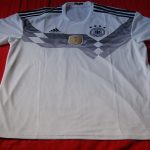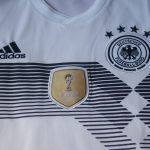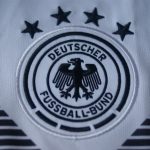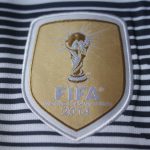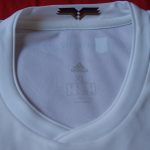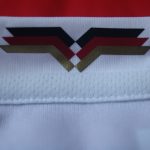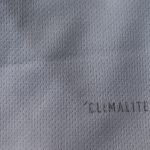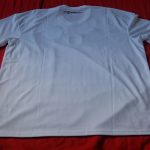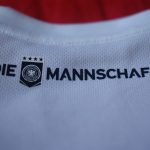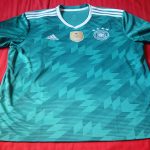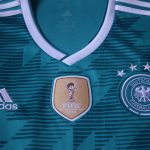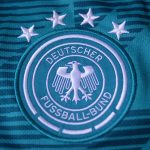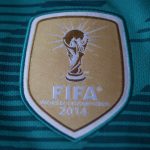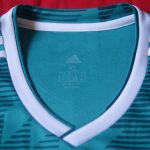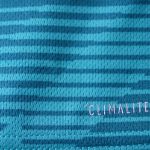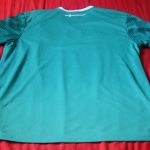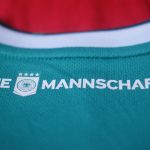Colours
Home: white shirt with black trim, black shorts, white socks
Away: teal green shirt with white trim, white shorts, teal green socks
Overview
Coach: Joachim Löw.
If the short-lived Confederations Cup design took its cue from the green away shirt sported at Italia 1990 with its “watermarked” pattern, the white Heimtrikot first seen in October 2017 would pay homage to what is arguably the greatest Nationaltrikot of all time. The white “flag” shirt that was worn for four years between 1988 and 1992.
The layout is rather like a slightly faulty monochrome photocopy of the 1990 design, with the three “shades” created by black horizontal lines of decreasing thickness. The design is undoubtedly modern, but with a clear reference to the traditional Schwarz und Weiss look.
The adoption of the monochrome style meant that it was the first time since 1986 that the white home shirt would have no colour in it. The layout of the design is the horizontally flipped reverse of the original, with the “dip” appearing on right immediately below the national eagle rather than on the left under the Adidas logo. Like the 1990 design, this new version shares the same classic white scalloped collar.
Joshua Kimmich in action in the 2017-19 Heimtrikot, against England at Wembley
As with the 1990 Nationaltrikot, the three black Adidas stripes are on the shoulders, running down to the point where they meet the new monochrome “flag”. The one subtle difference is that while the original Schwarz-Rot-Gold “flag” wrapped over the arms to finish on the back of the shirt, the new monochrome design stops at the sleeves on the front.
All of the features on the front of the Heimtrikot are stitched to a high quality finish. The Adidas three bars logo is stitched in fine black thread, as is the national eagle device and the four championship stars. In the centre is the FIFA World Champions shield, which is stitched in fine old gold thread with a white border.
Closer inspection reveals that there is some colour in the shirt in the form of a small Schwarz-Rot-Gold device, but neatly and subtly tucked away on the inside of the neck.
The white shirt is teamed with the traditional black shorts with white trim and detailing. The three traditional Adidas stripes run down the sides, with the national crest on the left and the squad number on the right. A small Adidas logo appears on the back of the shorts on the other side of the three stripes next to the number.
The kit is completed with white socks, the simplest of simple designs. Plain white, with the three Adidas stripes in black running horizontally at the top and the the letters “DFB”, also in black.
Rather than just being a modern revamp of the 1990 vintage, the intricate layout of the new teal green Auswärtstrikot draws on influences from a number of past Adidas kit features. If anything, it can be described as a coordinated melange of different designs from different eras.
While green has always been the second colour of the DFB, this darker shade of teal green was used for most of the 1990s – as opposed to the more traditional Lindengrün, or lime green.
The shapes and patterns of the core design is intended to trigger memories of the shirt worn in the 1990 FIFA World Cup semi-final against England in Torino. The design is not quite the same as the now iconic “patchwork” layout of the original, but rather a composite tiling of the very simple design seen on the home shirt – the same three “shades” created by black horizontal lines of decreasing thickness.
Like the Heimtrikot, the three white Adidas shoulder stripes do not extend down the sleeves. The overlapping white V-neck collar is another old school style, first seen on the green away shirt during the mid-1980s and, of course, on the famous Italia 1990 version. There are no additional colours, confirming the break with more recent tradition.
The team celebate Thomas Müller’s goal against Spain, the first in the new Auswärtstrikot
The Adidas logo on the front of the shirt is stitched in fine white/silver thread, as are the national eagle crest and four championship stars. As with the home shirt, the old gold FIFA world champions patch is in the centre, neatly integrated into the design with a white border.
Both the shorts and socks of the away kit follow the simple pattern as the home ensemble. The white away shorts are exactly the same design as the black home version, but with the three stripes in teal green and the national crest, player number and Adidas logo all in black. Completing the kit are teal green socks, with three horizontal stripes and “DFB” lettering in white.
The “back to the future” appearance of the both Trikots are accentuated by the introduction of a new “Russian” font for the player names and numbers, sported by all of the teams wearing Adidas kits at the 2018 FIFA World Cup. At first glance the numbers look like they belong on a primitive electronic scoreboard one might have found in the former Eastern Bloc.
From champions to chasers
Following Germany’s group phase elimination in Russia, the DFB would have to relinquish the FIFA shield in the front of the Nationaltrikot. Unlike in 2014, there would be no design changes to the shirts themselves, save for the removal of the gold patch in the centre of the chest.
This, technically, would be the 2018/19 design.
Tournament Record
2018 FIFA World Cup, Russia: group phase
Shirt Debut
White: v England, 10.11.2017, Wembley.
Team: ter Stegen – Ginter, Hummels (c), Rüdiger – Kimmich, Halstenberg* – Gündogan (86. Rudy) – Özil – Draxler (67. Can), Sané (86. Brandt) – Werner (73. Wagner)
Score: 0-0 (– / –)
Green: v Spain, 23.03.2018, Düsseldorf.
Team: ter Stegen – Kimmich, Boateng, Hummels, Hector – Khedira (c) (53. Gündoğan), Kroos – Müller (81. Goretzka), Özil, Draxler (68. Sané) – Werner (84. Gómez)
Score: 1-1 (Müller 35. / Rodrigo Moreno 7.)
Shirt Images
